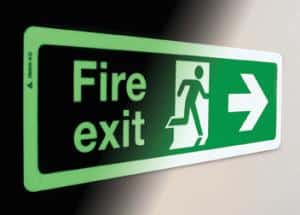How do photoluminescent signs work?
Photoluminescence occurs when a material absorbs photons (light energy) and then emits them back when the light source is removed i.e. in the dark, creating a noticeable lighting effect. Photoluminescent safety signs are designed to absorb photons from ambient light and then re-emit them in darkened conditions.
With a internal lifespan of up to 25 years they can also save money by not using electricity. Being maintenance free there is no need for costly regular testing regimes associated with ensuring the correct functionality of electrical signs. We have extended the use of photoluminescent material beyond fire safety signs with many other health and safety signs including hazard signs, prohibition signs, chemical safety signs, first aid signs and custom signage requirements. We have also created floor signs and tapes to aid your wayfinding during emergency evacuations.
Cost savings with photoluminescent signage
In addition to their cost effectiveness, eco-friendly safety signs are also more reliable than traditional exit signs due to increased visibility due to their natural ability to glow in the dark. Free from light bulbs they are the optimal signage solution in the event of emergency situations that result from structural shock falling debris. Using eco-friendly photoluminescence signs alongside your electrical fire exit signs is a cost effective way to help a companies’ journey to ‘go green’.
Reduce your carbon footprint
Going green and being environmentally friendly is a hot topic for businesses. As well as being cost effective and functional there are additional environmental benefits of using photoluminescent signs.Many companies are committed to recycling and purchasing non-toxic supplies, but still work in buildings whose materials, electrical systems and waste systems have been in place long before being “eco” became the business buzz word of the moment and before the economic benefits of being green were truly understood. Different companies will have different factors to consider when improving their green credentials. For example, a solicitors firm will have different concerns than a construction site. Electrical fire safety signs are environmentally unfriendly due to their never-ending demand for electricity. Being lit 24 hours a day, 365 days a year, they also contribute to driving up companies’ fuel costs. Therefore by using photoluminescent signs brings both an economical and an environmental benefit. Often recognised as best practice in the UK, photoluminescent sign systems have also been adopted throughout the EU and USA.
How to use your photoluminescent signs
For your signs to be effective they will require initial activation from a good light source – this can be natural or artificial. Check out our video below to get the most out of your signs:
https://www.youtube.com/watch?v=OMU_oxGwcbk


